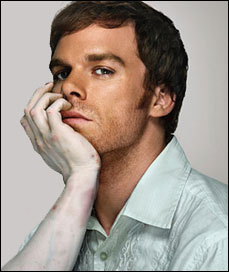
Dexter dates a single mother whose ex husband traumatized her with abuse. She is incapable of sexual affection. She has two children. His boss, despite his ability to solve difficult murder cases, hates him. He’s charming, funny, sensitive, generous, attentive, supportive, and slow to anger.
If you think he’s too good be true, you’re right because he is a serial killer. Methodical, detached, merciless, cruel. He stalks his victims-studying their habits with an unflinching eye. When he is confident his plans are flawless, he abducts his intended victim and before chopping them to pieces while they are still alive using a variety of tools, he extracts a drop of blood for a slide-the only trophy he keeps of his victims. The only thing to left of his victims after he disposes of the rest of the body.
But what makes Dexter interesting is his choice of victim-other serial killers.
Despite his sociological inability to empathize or even achieve the simplest connection to others, including his foster sister, Dexter has a rigid sense of morality. Since he must kill, he purges his desire by killing those whose demise will improve the safety of the community-pedophilic and sadistic serial killers.
Dexter is, in other words, living embodiment of Robespierre’s claim that, “Terror is nothing more than justice. Prompt, severe, and inflexible.” He also seems to prove the Machiavellian credo that sometimes the greater good is obtained by indulging in intensely evil and corrupt acts.
Dexter may, in fact, have been inspired by two real serial killers: John Bunting and Robert Wagner. These two men claimed that they murdered pedophiles because they were doing “terrible things to children…” Although some of the victims were pedophiles, Bunting and Wagner later opened their victim pool so wide, they even murdered their own friends. Further Dexter’s charm and attractiveness as well as his intelligence are reminiscent of famed serial killer Ted Bundy, who attended law school.
 Monsters have a way of becoming over time romantic heroes. Vampires, once considered foul disgusting monsters reeking of rotting flesh, have now become beautiful victims of circumstance-no less heroic than tuberculars in a Victorian novel. The Hunchback of Notredame went so far as to become a Disney cartoon. Dexter follows in the cinematic tradition of John Doe in Seven, Jigsaw in the Saw franchise, and Hayley in Hard Candy. What makes these characters sympathetic is their choice of victims.
Monsters have a way of becoming over time romantic heroes. Vampires, once considered foul disgusting monsters reeking of rotting flesh, have now become beautiful victims of circumstance-no less heroic than tuberculars in a Victorian novel. The Hunchback of Notredame went so far as to become a Disney cartoon. Dexter follows in the cinematic tradition of John Doe in Seven, Jigsaw in the Saw franchise, and Hayley in Hard Candy. What makes these characters sympathetic is their choice of victims.
Although Showtime claims in its press release that the show is supposed to make the viewer question certain ethical questions, it’s fairly clear from the way the scenes are cut that Dexter is supposed to be sympathetic. Otherwise, why would the camera cut away right before his victims are killed? To spare the viewer from having to see the reality of Dexter’s murderous apathy. The cutaways allow us to identify with him without having to question the cruelty of his acts (unlike in Hard Candy which makes it very explicit). Dexter is part wish fulfillment-a charming attractive vigilante serial killer who worries about safe driving-and part reflection-manipulative, fake and apathetic.
This is not to say that I don’t enjoy the show. When it was announced that Showtime was going to do a show about a serial killer, I was worried it was going to degenerate into cliché, but everything goes against expectation from the casting to the light design, and even the cubano influenced music. Michael C. Hall, best known for his portrayal as David on Six Feet Under, is cast here as the charismatic and confident Dexter while Julie Benz, formerly Darla on Buffy the Vampire Slayer and Angel, plays his traumatized girlfriend. The set designed utilizes mostly white contrasting with some red and black, which very different from the trend of earthy-tones shadowy horror movies of the past year (Hostel,Wolf Creek, Texas Chainsaw Massacre: The Beginning). Horror is often a genre associated with shadows and darkness. This show goes in the opposite direction-the murders happen under flood lights even when perpetrated in an abandoned warehouse at night.Even the costuming choices are subtle and effective. When Dexter leaves the scene of a particularly unusual murder, he is wearing a dark grey shirt while the crowd around him dressed in light pastels. This contrast suggests that Dexter is not like the rest, that he doesn’t belong.
The writing is also playful which invites and intrigues the viewer in the same way that Humbert Humbert’s word games seduce readers in the novel Lolita. Dexter’s boat is called “The Slice of Life”, an interesting double entendre. Much like the lead in American Psycho, Dexter is self aware proclaiming himself to be a “very neat monster.” But unlike Patrick Bateman, Dexter has an objective sense of right and wrong that is not distorted by emotional detachment. When a pedophilic serial killer is about to find himself Dexter’s next victim, he asks Dexter why he is superior. “Because I have standards,” is the cold response. Perhaps my most perverted moment of enjoyment was when Dexter talks about the surreal nature of going to a murder scene in Miami during the daylight hours and refers to it to it “as being like a new and daring section of Disney World called Dahmerland.”
Sick. Sick and funny.
